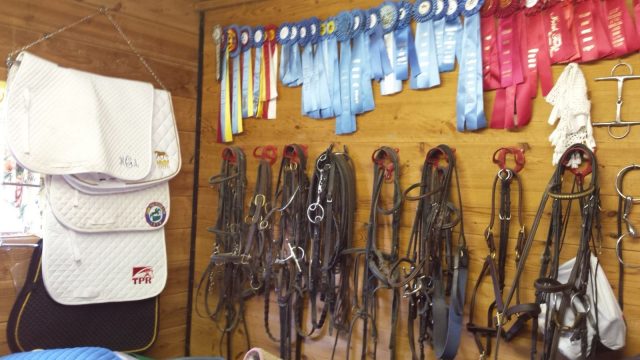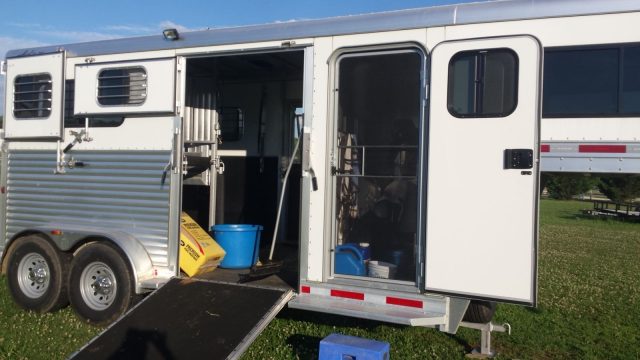
A youth pipeline is vital. Photo by Holly Covey
You can’t have a sport without a youth pipeline. Every successful sport has one. Bringing up children on ponies, then teens on horses, and finally, young adults on event horses keeps our sport alive — literally.
So, even if you, as an adult eventer, may not have a dog in the young rider hunt, you can recognize the vital importance of the Junior and Young Rider programs in supporting eventing horsemanship and sportsmanship. Our sport has a future, basically because each Area in the United States funds Young Rider (riders aged 16 to 21 years) teams to go to an international competition, and learn what it takes to compete at a high level.
Young Rider programs are different from USPC (Pony Club) programs, and different from regular horse trials with junior divisions. Young Riders are encouraged on an international scale, with a whole set of FEI rules. In the United States, we have developed our Young Rider program on a USEA area by area basis, which helps our vast nation put together young rider teams that can compete at our own North American Junior and Young Rider Championship. Eventing is only one division of the NAJYRC; show jumping and dressage also participate.
In 2018, the NAJYRC for show jumping (including Children’s classes) and dressage will be held at Old Salem Farm, North Salem, NY. For eventing, it will again be held at Rebecca Farms, as a part of The Event At Rebecca Farms, in Kalispell, MT., July 18-22. Young Riders compete at the one star and two star levels.
I’d like to take a moment and talk about the experience that these riders may have. While not all make the team, and not all get to ride at the championships, they are encouraged to attend and belong to the group. This promotes a sense of comaraderie, creates lifelong friendships, teaches children how to get along with one another and rely and learn from one another. It exposes the kids to other ways of doing things, how to live and work together, and the process of changing ones’ mindset from “me” to “us.” The value of this is beyond compare in the horse world and probably spills over to the rest of their lives, too.
In addition to the personal expansion, a young rider does go through a selection process with their horses, their coaches, and family members. How great is that? We are teaching a young rider, still in their formative years, the value of riding under pressure and the importance of detail, preparation, organization, and horsemanship to achieve a goal. Isn’t that what we’d like to see, going forward — riders representing America that can handle the pressure in top international competition. Not bad.
Quite a few of our upper level riders today had Young Rider experiences. Most of them think fondly of their competition team experience — a few credit it with helping them become the professional riders they are today.
Here’s what Murray Kessler, president of the USEF, has to say about the Young Rider championship program: “These championships are a very important part of the developmental pathway that USEF must prioritize. For many young athletes, this is the first time that they will get championship experience or the opportunity to compete as part of a team representing their country, so these championships are a big deal.”
Young riders and their families also have a positive impact financially on the sport and provide support for organizations, events, trainers, coaches, suppliers and services that work within the industry. Their contributions are mighty, and the economic impact is important. Ask yourself if you’re someone who has benefited directly from coaching, training or selling a horse to a young rider. A healthy Young Rider (or Young Rider advancement program) is a good thing for your business.
So, what are you doing to help? Perhaps you are assisting with your Young Rider team, supporting their fundraisers (team participation is very expensive, often in the thousands and many riders need the help of donated funds), giving time, or a facility for training — encouraging the kids in your barn to join a YRAP (Young Riders Advancement Program).
In Area II, the YRAP helps kids go behind the scenes and shadow officials at recognized events. Most of these kids are eventing and riding at the Novice or Training level, or may not be old enough yet to join the YR program (age 16 to 21); YRAP in Area II gives them a taste of the things they need to know in order to move up to Young Riders competition, and offers them some recognition, sets up teams at recognized events and helps prepare parents and coaches, too.
Fundraising is a major part of support for the YR teams, and that is because any qualified rider should not be held back from participating because of finances. It’s always a good thing to have a fund to help everyone on the team participate, even if some riders are more able to afford the travel required. Most of the east coast teams in 2017 and looking forward to 2018 are having to raise lots of funds to help get horses to Montana from the east coast, just like many of the west coast young riders in the past have had to raise funds to help get east, when the NAJYRCs are held on the eastern side of the U.S. Because of the large size of the U.S. and Canada, our young rider competitors are used to long travel distances to participate in these championships — they are a big deal and they require commitment from families in a big way.
So as an eventer, I’d like to think that you understand the need for helping out our Young Rider programs, and can find a way to help support the various fundraisers that each Area has to help their kids get to Montana this year.
Here are links to Area fundraising programs, or just their websites if they don’t have a fundraising specific page —Area I, Area II, Area III, Area VI, Area V, Area VI, Area VII, Area VIII, Area IX, Area X. Eventing Nation is always happy to help get the word out about YR fundraising efforts: You can email us details at [email protected].
In addition, there’s some more support you can offer, and that has to do with being an adult, and creating a positive attitude for the kids who are dreaming the Big Dream of Young Riders. While it’s easy to post on social media what your opinion might be on Young Rider programs in your area, there’s a pretty serious impact you might be having on those kids who read those comments — it never hurts to know a little bit about the influence you as an adult eventer might be having.
This is taken from an article written by Brian McNeill, a 4-H Youth development specialist with the University of Minnesota Extension. It applies pretty closely to our Young Riders.
“Non-parental adults in community organizations play an important role with youth. Studies done with 4-H youth show adults in their 4-H clubs make them feel important (65%) and listen to them (64%). In addition, most youth reported that their volunteer leaders do pay attention to them (74%)
“Some specific characteristics of non-parental adults who play this role include that they are: Good listeners; supporters: and have a good sense of youth development.
“Organizations that work with young people want a positive and successful experience for the youth they serve. Expecting and encouraging these characteristics in non-parental adults ensures they are creating the most positive experience possible for the young people.”
So as non-parental adults (and I emphasize “adults” here), it is up to us in this sport as caring people to make sure we make all of our actions for Young Riders POSITIVE. They have enough disappointment, downers and difficulties to surmount in the sport of eventing, as we all know. This sport is HARD. The young riders who have chosen this path deserve only support and “the most positive experience possible” by all adults who have anything to do with this program, on or off the field.
Our leadership example sets the tone. I’d like to see today’s young riders become tomorrow’s sport leaders — and, hopefully, what they learn from us will help them to work towards making our sport survive — and leave it better than we give it to them.
What can you do? Encourage young riders you interact with. Be a fan of your local young rider team. Support fundraisers, “like” and share the links, give something if you can. Have positive messages. Come out and cheer and support them when they compete. Be a positive force that encourages others, because you don’t know when — or how — you will influence a young person.
Our sport depends on it.



























 Oh there is so much more I remember from then, but this will have to do for now. I hope everyone is planning right now to volunteer or attend in 2028!
Oh there is so much more I remember from then, but this will have to do for now. I hope everyone is planning right now to volunteer or attend in 2028!





















